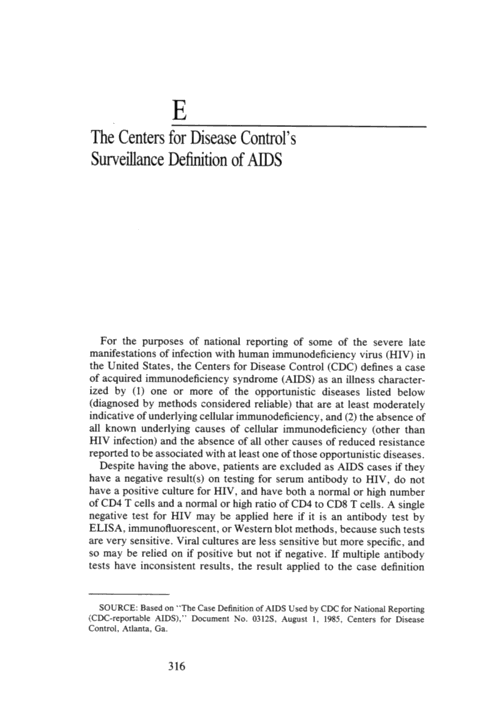Below is the uncorrected machine-read text of this chapter, intended to provide our own search engines and external engines with highly rich, chapter-representative searchable text of each book. Because it is UNCORRECTED material, please consider the following text as a useful but insufficient proxy for the authoritative book pages.
E The Centers for Disease Control's Surveillance Definition of AIDS For the purposes of national reporting of some of the severe late manifestations of infection with human immunodeficiency virus (HIV) in the United States, the Centers for Disease Control (CDC) defines a case of acquired immunodeficiency syndrome (AIDS) as an illness character- ized by (1) one or more of the opportunistic diseases listed below (diagnosed by methods considered reliable) that are at least moderately indicative of underlying cellular immunodeficiency, and (2) the absence of all known underlying causes of cellular immunodeficiency (other than HIV infection) and the absence of all other causes of reduced resistance reported to be associated with at least one of those opportunistic diseases. Despite having the above, patients are excluded as AIDS cases if they have a negative results) on testing for serum antibody to HIV, do not have a positive culture for HIV, and have both a normal or high number of CD4 T cells and a normal or high ratio of CD4 to CD8 T cells. A single negative test for HIV may be applied here if it is an antibody test by ELISA, immunofluorescent, or Western blot methods, because such tests are very sensitive. Viral cultures are less sensitive but more specific, and so may be relied on if positive but not if negative. If multiple antibody tests have inconsistent results, the result applied to the case definition SOURCE: Based on "The Case Definition of AIDS Used by CDC for National Reporting CDC-reportable AIDS)," Document No. 0312S, August 1, 1985, Centers for Disease Control, Atlanta, Ga. 316
APPENDIX E 317 should be that of the majority. A positive culture, however, would overrule negative antibody tests. In the absence of test results, patients satisfying all other criteria in this definition are included as cases. This general case definition can be made more explicit by specifying the particular diseases considered at least moderately indicative of cellular immunodeficiency that are used as indicators of AIDS. In the following list of diseases, the required diagnostic methods with positive results are shown in parentheses. "Microscopy" may include cytology. Protozoal and Helminthic Infections - 1. Cryptosporidiosis, intestinal, causing diarrhea for over one month (on histology or stool microscopy). 2. Pneumocystis carinii pneumonia (on histology or microscopy of a "touch" preparation, bronchial washings, or sputum). 3. Strongyloidosis causing pneumonia, central nervous system infec ~r infe.~.tinn rlisseminated beyond the gastrointestinal tract (on tion, V1 BAA ~ J histology). 4. Toxoplasmosis causing infection in internal organs other than the liver, spleen, or lymph nodes (on histology or microscopy of a "touch" preparation). Fungal Infections 1. Candidiasis causing esophagitis (on histology, microscopy of a "wet" preparation from the esophagus, or endoscopic or autopsy findings of white plaques on an erythematous mucosal base, but not by culture alone). 2. Cryptococcosis causing central nervous system or other infection disseminated beyond lungs and lymph nodes (on culture, antigen detec- tion, histology, or India ink preparation of cerebrospinal fluid). Bacterial Infections 1. Mycobacterium avium or intracellulare (Mycobacterium avium com- plex) or Mycobacterium kansasii causing infection disseminated beyond lungs and lymph nodes (on culture). . Viral Infections 1. Cytomegalovirus causing infection in internal organs other than the liver, spleen, or lymph nodes (on histology or cytology but not by culture or serum antibody titer). 2. Herpes simplex virus causing chronic mucocutaneous infection with ulcers persisting more than one month or pulmonary, gastrointestinal
318 APPENDIX E tract (beyond mouth, throat, or rectum), or disseminated infection, but not encephalitis alone (on culture, histology, or cytology). 3. Progressive multifocal leukoencephalopathy, presumed to be caused by papovavirus (on histology). Cancer 1. Kaposi's sarcoma (on histology). 2. Lymphoma limited to the brain (on histology). Other Opportunistic Infections with Positive Test for HIV In the absence of the above opportunistic diseases, any of the following diseases is considered indicative of AIDS if the patient had a positive test for HIV: 1. Disseminated histoplasmosis (on culture, histology, or cytology). 2. Bronchial or pulmonary candidiasis (on microscopy or visualization grossly of characteristic white plaques on the bronchial mucosa, but not by culture alone). 3. Isosporiasis causing chronic diarrhea of over one month (on histol- ogy or stool microscopy). Chronic Lymphoid Interstitial Pneumonitis In the absence of the above opportunistic diseases, a histologically confirmed diagnosis of chronic (persisting over two months) lymphoid interstitial pneumonitis in a child (under 13 years of age) is indicative of AIDS unless testis) for lIIV are negative. The histologic examination of lung tissue must show diffuse interstitial and peribronchiolar infiltration by lymphocytes, plasma cells with Russell bodies, plasmacytoid lympho- cytes, and immunoblasts. Histologic and culture evaluation must not identify a pathogenic organism as the cause of this pneumonia. Non-Hodgkin's Lymphoma with Positive Test for HIV If the patient had a positive test for HIV, then the following histologic types of lymphoma are indicative of AIDS, regardless of anatomic site: 1. Small noncleaved lymphoma (Burkitt's tumor or Burkitt-like lym- phoma), but not small cleaved lymphoma. 2. Immunoblastic sarcoma (or immunoblastic lymphoma) of B-cell or unknown immunologic phenotype (not of T-cell type). Other terms that may be equivalent include diffuse undifferentiated non-Hodgkin's lym- phoma, large-cell lymphoma (cleaved or noncleaved), diffuse histiocytic lymphoma, reticulum cell sarcoma, and high-grade lymphoma.
~ E 319 Lymphomas should not be accepted as indicative of AIDS if they are described in any one of the foNowing ways: low grade, of T-ceN type Immunologic phenotypes smaN craved lymphoma, lymphocyOc lym- phoma (regardless of whether weN or poorly differentiated), lymphoblas- dc lymphoma, plasmacytoid lymphocytes lymphoma, lymphocy~c leuke- mia (acute or chronic), or Hodgkin's disease (or Hodgkin's lymphoma).




